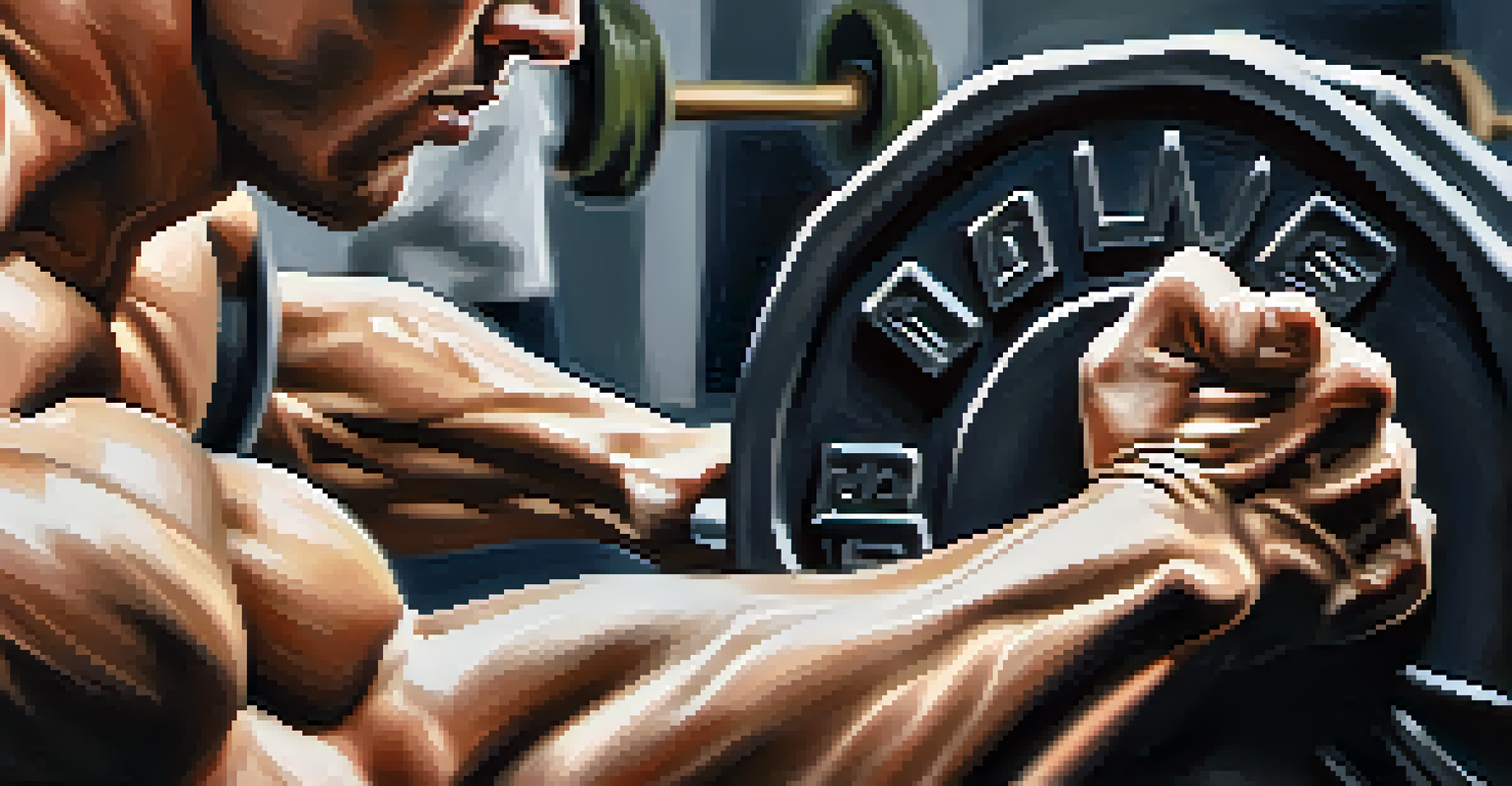Essential Warm-Up Techniques for Bodybuilding Injury Prevention

Understanding the Importance of Warm-Ups in Bodybuilding
Warm-ups are crucial for preparing your body for the intense activity of bodybuilding. They help increase blood flow to muscles, which enhances performance and reduces the risk of injury. Think of a warm-up like warming up an engine before driving; it ensures everything runs smoothly.
The secret of getting ahead is getting started.
Additionally, warm-ups mentally prepare you for the workout ahead. They create a routine that signals your brain to switch gears from rest to exercise. This mental preparation can lead to better focus and performance while lifting weights.
Finally, a proper warm-up can improve your range of motion, making your lifts more effective. By gradually increasing your heart rate and loosening your joints, you’ll find it easier to complete each rep with the correct form.
Dynamic Stretching: A Key Component of Warm-Ups
Dynamic stretching involves moving parts of your body through their full range of motion, which is perfect for warming up. Instead of holding stretches, dynamic movements like leg swings and arm circles prepare your muscles for action. This active approach not only warms up the body but also enhances flexibility.

Incorporating dynamic stretches into your warm-up routine can significantly reduce the risk of injuries. For instance, exercises like walking lunges or torso twists mimic the movements you'll perform during your workout. This specificity can help your body adapt to the demands of lifting weights.
Warm-Ups Prevent Injuries
Proper warm-ups increase blood flow and improve range of motion, reducing the risk of injury during bodybuilding.
Moreover, dynamic stretching can be fun and engaging, making it easier to stick to your routine. By varying your movements each session, you keep things fresh and enjoyable, which is essential for long-term commitment to bodybuilding.
The Role of Mobility Drills in Injury Prevention
Mobility drills are exercises designed to improve the movement quality of your joints. These drills can help identify tight areas that may lead to injuries if not addressed. Just like a car needs proper alignment for a smooth ride, your body needs optimal mobility to perform well.
Take care of your body. It's the only place you have to live.
Incorporating mobility drills such as hip openers or shoulder dislocates before lifting can enhance your performance. These exercises help loosen up key areas that are often tight, allowing for a fuller range of motion during your workout. The result is not just injury prevention but also improved lifting technique.
Additionally, performing mobility drills regularly can lead to long-term benefits. Over time, you'll notice increased flexibility and strength, which can translate into better results in your bodybuilding journey. It’s all about nurturing your body for the heavy lifting ahead.
Incorporating Specific Warm-Up Sets for Each Workout
Specific warm-up sets involve doing lighter versions of the exercises you plan to perform. For instance, if you're planning to squat heavy, starting with the barbell and gradually adding weight can prepare your muscles for the load. This approach effectively primes your body for the workout without risking injury.
Moreover, specific warm-up sets allow you to focus on your form before adding heavier weights. This practice is crucial because poor form can lead to injuries, especially with complex lifts. By ensuring your technique is sound when the weights are light, you’re setting yourself up for success.
Dynamic Stretching Enhances Flexibility
Incorporating dynamic stretches into your routine prepares your body for action and enhances flexibility through active movements.
Remember, the goal of specific warm-up sets is not just to prepare physically but also mentally. As you gradually increase weight, you build confidence in your abilities, making it easier to tackle your heaviest lifts with assurance and control.
Utilizing Foam Rolling as a Pre-Workout Tool
Foam rolling is a form of self-myofascial release that can significantly benefit your warm-up routine. By applying pressure to specific areas, you can release muscle tightness and improve blood flow. Think of it as giving your muscles a gentle massage, prepping them for the work ahead.
Incorporating foam rolling into your warm-up can help identify areas of discomfort or tightness before you start lifting. This self-assessment allows you to focus on problem areas and tailor your warm-up accordingly. It’s a simple yet highly effective strategy for injury prevention.
Additionally, foam rolling can feel great and is a fantastic way to relax before an intense workout. Taking a few minutes to roll out can reduce tension and increase your overall sense of well-being, making your workout more enjoyable.
The Importance of Gradual Intensity Increase in Warm-Ups
Gradually increasing the intensity of your warm-up is essential for preparing your body for the demands of bodybuilding. Jumping straight into heavy lifts can shock your muscles and joints, leading to injuries. Instead, start with low-intensity movements and progressively ramp up to your working weight.
This gradual approach allows your cardiovascular system to adjust, ensuring that your heart rate and blood flow are optimal for performance. It’s similar to how a runner wouldn’t sprint right out of the gate; they’d start with a jog to ease into it.
Listen to Your Body's Needs
Adjusting your warm-up based on how your body feels ensures a more effective routine and promotes long-term success in bodybuilding.
Additionally, a well-structured warm-up with increasing intensity can enhance your overall strength output. By the time you hit your heaviest sets, your body is fully primed and ready to perform at its best, reducing the likelihood of injury.
Listening to Your Body: Adjusting Warm-Ups as Needed
Every day your body feels different, and it's essential to listen to those signals when warming up. If you're feeling particularly tight or fatigued, you may need to adjust your warm-up routine accordingly. Consider this like tuning an instrument; sometimes, you need to make small adjustments to get the best sound.
Pay attention to how your body responds to various warm-up techniques. If certain stretches or drills feel uncomfortable, it's okay to modify or replace them with alternatives that suit you better. This personalized approach can lead to a more effective warm-up and improved performance.

Ultimately, embracing the idea of adjusting your warm-up is a sign of a mature athlete. It shows you understand your body and its needs, which is crucial for long-term success and injury prevention in bodybuilding.